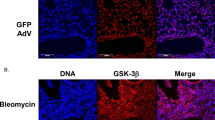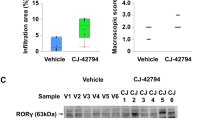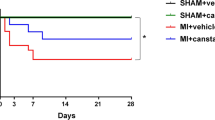Abstract
In viral myocarditis, inflammation and destruction of cardiac myocytes leads to fibrosis, causing progressive impairment in cardiac function. Here we show the etiologic importance of serine elastase activity in the pathophysiology of acute viral myocarditis and the therapeutic efficacy of an elastase inhibitor. In DBA/2 mice inoculated with the encephalomyocarditis virus, a more than 150% increase in myocardial serine elastase activity is observed. This is suppressed by a selective serine elastase inhibitor, ZD0892, which is biologically effective after oral administration. Mice treated with this compound had little evidence of microvascular constriction and obstruction associated with myocarditis-induced ischemia reperfusion injury, much less inflammation and necrosis, only mild fibrosis and myocardial collagen deposition, and normal ventricular function, compared with the infected nontreated group.
This is a preview of subscription content, access via your institution
Access options
Subscribe to this journal
Receive 12 print issues and online access
$209.00 per year
only $17.42 per issue
Buy this article
- Purchase on Springer Link
- Instant access to full article PDF
Prices may be subject to local taxes which are calculated during checkout






Similar content being viewed by others
References
Fallon, J.T. Myocarditis and dilated cardiomyopathy: Different stages of same disease? in Contemporary issues in Cardiovascular Pathology. Cardiovasc. Clin. Ser. 18, 155–162 (1987).
Lieberman, E.B., Hutchins, G.M., Herskowitz, A., Rose, N.R. & Baughman, K.L. Clinicopathologic description of myocarditis. J. Am. Coll. Cardiol. 18, 1617–1626 (1991).
Liu, P., Wang, E.E.L. & Sole, M. Viral myocarditis: Changing concepts in pathogenesis and implications in diagnosis and treatment. Cardiovasc. Pathol. 2, 247–257 (1993).
Tesh, R.B. The prevalence of encephalomyocarditis virus neutralizing antibodies among various human populations. Am. J. Trop. Med. Hyg. 27, 144–149 (1978).
Neumann, D.A., Burik, K.L., Rose, N.R. & Herskowitz, A. Circulating heart-reactive antibodies in patients with myocarditis and cardiomyopathy. J. Am. Coll. Cardiol. 16, 839– 846 (1990).
Matsumori, A. & Kawai, C. An animal model of congestive (dilated) cardiomyopathy: Dilatation and hypertrophy of the heart in the chronic stage in DBA/2 mice with myocarditis caused by encephalomyocarditis virus. Circulation 66, 355–360 (1982).
Kishimoto, C. & Abelmann, W.H. In vivo significance of T cells in the development of Coxsackievirus B3 myocarditis in mice. Immature but antigen-specific T cells aggravate cardiac injury. Circ. Res. 67, 589–598 (1990).
Hirasawa, K. et al. Depletion of Mac1-positive macrophages protects DBA/2 mice from encephalomyocarditis virus-induced myocarditis and diabetes. J. Gen. Virol. 77, 737–741 (1996).
Lane, J.R., Neumann, D.A., Lafond-Walker, A., Herskowitz, A. & Rose, N.R. Interleukin 1 or tumor necrosis factor can promote coxsackie B3-induced myocarditis in resistant B10.A mice. J. Exp. Med. 175, 1123–1129 (1992).
Yamada, T., Matsumori, A. & Sasayama, S. Therapeutic effect of anti-tumor necrosis factor-× antibody on the murine model of viral myocarditis induced by encephalomyocarditis virus. Circulation 89, 846– 851 (1994).
Takada, H., Kishimoto, C. & Hiraoka, Y. Therapy with immunoglobulin suppresses myocarditis in a murine coxsackievirus B3 model. Antiviral and anti-inflammatory effects. Circulation 92, 1604–1611 (1995).
Constanzo-Nordin, M.R., Reap, E.A., O'Connel, J.B., Robinson, J.A. & Scanlon, P.J. A nonsteroidal anti-inflammatory drug exacerbates coxsackievirus B3 murine myocarditis. J. Am. Coll. Cardiol. 6, 1078–1082 (1985).
Kishimoto, C. & Abelmann, W.H. Absence of effects of cyclosporine on myocardial lymphocyte subsets in coxsackievirus B3 myocarditis in the aviremic stage. Circ. Res. 65, 934– 945 (1989).
Kishimoto, C., Thorp, K.A. & Abelmann, W.H. Immunosuppression with high doses of cyclophosphamide reduces the severity of myocarditis but increases mortality in murine coxsackievirus B3 myocarditis. Circulation 82, 982– 989 (1990).
Silver, M.A. & Kowalczyk, D. Coronary microvascular narrowing in acute murine coxsackie B3 myocarditis. Am. Heart J. 118, 173–174 (1989).
Factor, S.M., Minase, T., Cho, S., Dominitz, R. & Sonnenblick, E.H. Microvascular spasm in the cardiomyopathic Syrian hamster: A preventable cause of focal myocardial necrosis. Circulation 66, 342–354 (1982).
Dong, R., Liu, P., Wee, L., Butany, J. & Sole, M.J. Verapamil ameliorates the clinical and pathological course of murine myocarditis. J. Clin. Invest. 90, 2022–2030 (1992).
Yamada, T., Matsumori, A., Okada, I., Tominaga, M. & Kawai, C. The effect of alpha 1-blocker, bunazosin on a murine model of congestive heart failure induced by viral myocarditis. Jap. Circ. J. 56, 1138–1145 (1992).
Tominaga, M., Matsumori, A., Okada, I., Yamada, T. & Kawai, C. Beta-blocker treatment of dilated cardiomyopathy. Beneficial effect of carteolol in mice. Circulation 83, 2021–2028 (1991).
Rezkalla, S., Kloner, R.A., Khatib, G. & Khatib, R. Beneficial effects of captopril in acute coxsackievirus B3 murine myocarditis. Circulation 81, 1039–1046 (1990).
Harlan, J.M., Killen, P.D., Harker, L.A. & Striker, G.E. Neutrophil-mediated endothelial injury in vitro. J. Clin. Invest. 68, 1394–1403 (1981).
Huber, A.R. & Weiss, S.J. Disruption of the subendothelial basement membrane during neutrophil diapedesis in an in vitro construct of a blood vessel wall. J. Clin. Invest. 83, 1122–1136 (1989).
Zimmerman, B.J. & Granger, D.N. Reperfusion-induced leukocyte infiltration: Role of elastase. Am. J. Physiol. 259, H390–H394 (1990).
Dinerman, J.L. et al. Increased neutrophil elastase release in unstable angina pectoris and acute myocardial infarction. J. Am. Coll. Cardiol. 15, 1559–1563 (1990).
Nicolini, F.A. et al. Leukocyte elastase inhibition and t-PA-induced coronary artery thrombolysis in dogs: Beneficial effects on myocardial histology. Am. Heart J. 122, 1245–1251 (1991).
Tiefenbacher, C.P., Niroomand, M.E.F., Tillmanns, S.B.H. & Kübler, R.Z.W. Inhibition of elastase improves myocardial function after repetitive ischemia and myocardial infarction in the rat heart. Eur. J. Physiol. 433, 563–570 (1997).
Cowan, B. et al. Elafin, a serine elastase inhibitor, attenuates post-cardiac transplant coronary arteriopathy and reduces myocardial necrosis in rabbits after heterotopic cardiac transplantation. J. Clin. Invest. 97, 2452–2468 (1996).
Oho, S. & Rabinovitch, M. Post-cardiac transplant arteriopathy in piglets is associated with fragmentation of elastin and increased activity of a serine elastase. Am. J. Pathol. 145, 202–210 (1994).
Crinnion, J.N., Homer-Vanniasinkam, S., Hatton, R., Parkin, S.M. & Gough, M.J. Role of neutrophil depletion and elastase inhibition in modifying skeletal muscle reperfusion injury. Cardiovasc. Surg. 2, 749–753 (1994).
Edwards, P.D. et al. Discovery and biological activity of orally active peptidyl trifluoromethyl ketone inhibitors of human neutrophil elastase. J. Med. Chem. 40, 1876–1885 (1997).
Veale, C.A. et al. Orally active trifluoromethyl ketone inhibitors of human leukocyte elastase. J. Med. Chem. 40, 3173– 3181 (1997).
Molla, A., Hellen, C.U.T. & Wimmer, E. Inhibition of proteolytic activity of poliovirus and rhinovirus 2A proteinases by elastase-specific inhibitors. J. Virol. 67, 4688–4695 (1993).
Seko, Y., Shinkai, Y. & Kawasaki, A. Expression of perforin in infiltrating cells in murine myocarditis caused by coxsackievirus B3. Circulation 84, 788–795 (1991).
Caforio A.L.P. et al. Novel organ-specific circulating cardiac autoantibodies in dilated cardiomyopathy. J. Am. Coll. Cardiol. 15, 1527–1534(1990).
Campbell, E.J., Silverman, E.K. & Campell, M.A. Elastase and cathepsin G of human monocytes. Quantification of cellular content, release in response to stimuli, and heterogeneity in elastase-mediated proteolytic activity. J. Immunol. 143, 2961–2968 (1989).
Senior, R.M. et al. Elastase of U-937 monocyte-like cells. Comparisons with elastases derived from human monocytes and neutrophils and murine macrophage-like cells. J. Clin. Invest. 69, 384– 393 (1982).
Tschopp, J. & Jogeneel, C.V. Cytotoxic T lymphocyte mediated cytolysis. Biochemistry 27, 2641– 2646 (1988).
Thompson, K. & Rabinovitch, M. Exogenous leukocyte and endogenous elastases can mediate mitogenic activity in pulmonary artery smooth muscle cells by release of extracellular matrix-bound basic fibroblast growth factor. J. Cell. Physiol. 166, 495– 505 (1996).
Romanic, A.M. & Madri, J.A. The induction of 72-kD gelatinase in T cells upon adhesion to endothelial cells is VCAM-1 dependent. J. Cell Biol. 125, 1165–1178 (1994).
Hauck, M. et al. Effects of synthesized elastin peptides on human leukocytes. Biochem. Mol. Biol. Int. 37, 45– 55 (1995).
Myers, M.L., Bolli, R., Lekick, R.F., Hartley, C.J. & Roberts, R. Enhancement of recovery of myocardial function by oxygen free-radical scavengers after reversible regional ischemia. Circulation 72, 915–921 (1985).
Frizelle, S., Schwarz, J., Huber, S.A. & Leslie, K. Evaluation of the effects of low molecular weight heparin on inflammation and collagen deposition in chronic coxsackievirus B3-induced myocarditis in A/J mice. Am. J. Pathol. 141, 203–209 (1992).
Bradley, P.P., Priebat, D.A., Christensen, R.D., & Rothstein, G. Measurement of cutaneous inflammation: Estimation of neutrophil content with an enzyme marker. J. Invest. Dermatol. 78, 206–209 (1982).
Keeley, F.W., Morin, J.D. & Vessely, S. Characterization of collagen from normal human sclera. Exp. Eye Res. 39, 533– 542 (1984).
Acknowledgements
We thank J. Jowlabar and S. Taylor for secretarial assistance and C. Coulber, S. Ciura, E. Sitarz and K. Aitken for technical assistance. We also thank the staff of the Animal Care Facility at The Toronto Hospital General Division for their support with animal care, and members of the Department of Pathology at The Hospital for Sick Children for preparing the specimens for microscopy. This work was supported by a grants #74026 and T-2373 from the Heart and Stroke Foundation of Ontario and from the Medical Research Council of Canada.
Author information
Authors and Affiliations
Rights and permissions
About this article
Cite this article
Lee, J., Zaidi, S., Liu, P. et al. A serine elastase inhibitor reduces inflammation and fibrosis and preserves cardiac function after experimentally-induced murine myocarditis. Nat Med 4, 1383–1391 (1998). https://doi.org/10.1038/3973
Received:
Accepted:
Issue Date:
DOI: https://doi.org/10.1038/3973
This article is cited by
-
Infectious myocarditis: the role of the cardiac vasculature
Heart Failure Reviews (2018)
-
Coagulation, Protease-Activated Receptors, and Viral Myocarditis
Journal of Cardiovascular Translational Research (2014)
-
Fulminant myocarditis
Nature Clinical Practice Cardiovascular Medicine (2008)
-
The interaction of coronary tone and cardiac fibrosis
Current Atherosclerosis Reports (2005)



